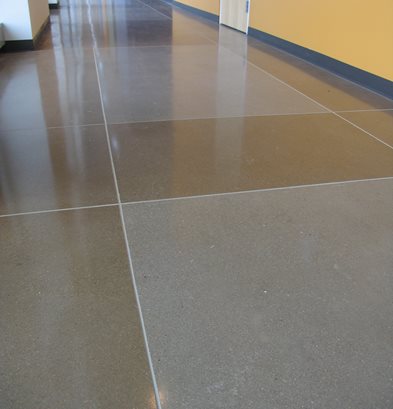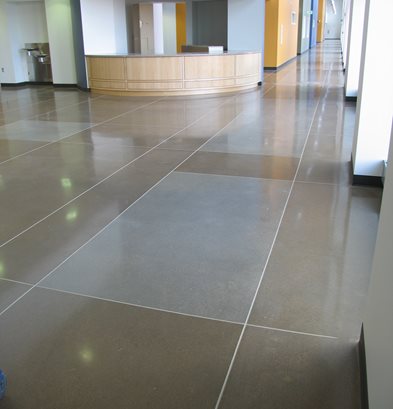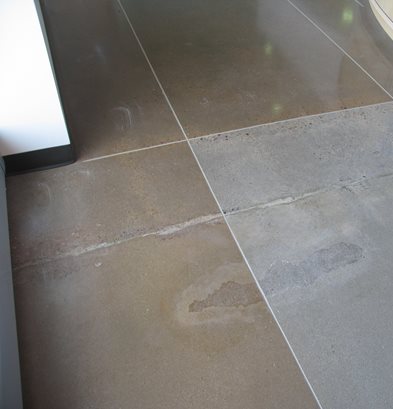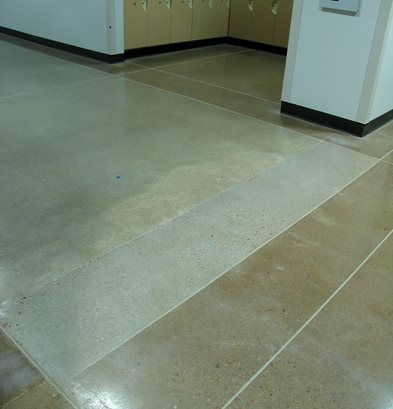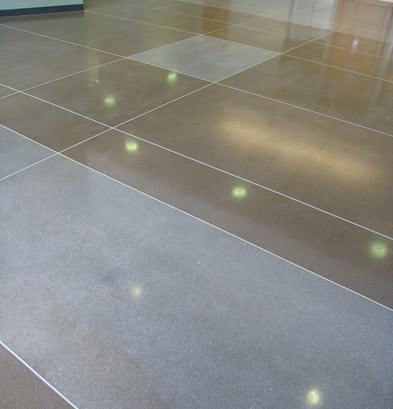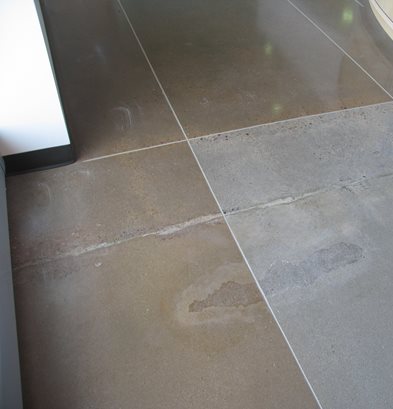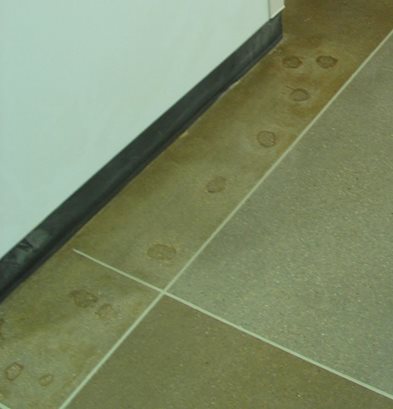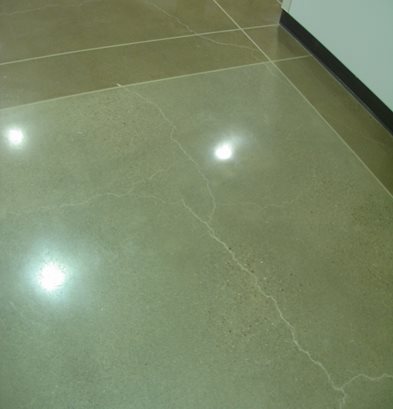- Polished Concrete Information
- Polished Concrete Pictures
- What is Polished Concrete
- Polished Concrete Cost
- Design Ideas for Polished Concrete
- Polished Concrete Maintenance
- Common Questions about Polished Concrete
- Can All Concrete be Polished?
- Comparison Chart: Polished concrete versus other flooring materials
- What are Polished Overlays?
- Polishing Products and Equipment: An overview of basic equipment and supplies needed
- Related Information
- Information About: Concrete Floors
- Concrete Contractors: Find Concrete Polishing Products and Suppliers
- Design Ideas: Polished Concrete Info
What to Expect from a Polished Concrete Floor
The polished and dyed concrete floor at the University of Colorado Health Sciences Center, Fitzsimmons Campus, Educational Facility 2, may look perfect in these pictures, but look closer.
"When you polish a concrete floor," said Colorado Hardscapes' John Buteyn, "the floor can only be as good as the concrete you're polishing allows it to be. We ran into improperly placed floor joints, patched areas, and cold joints right in the middle of the corridor. Cross bracing for the building resulted in some voids that had to be patched and all of those things show up in the polished floor. Although this floor was pretty flat, you still get a little curl at the joints which results in areas that grind deeper and expose more of the coarse aggregate. You can call these things flaws or you can just call them characteristic of a polished floor."
The critical thing, according to Buteyn, is to manage your customers' expectations. "This floor shows the good, the bad, and the ugly of polished floors. We are going to use it regularly to show people who want a polished floor what to expect. In the decorative concrete industry we all need to manage expectations, but especially with these floors. If they are expecting a perfect terrazzo floor for the cost of a polished floor they will be disappointed. It's a question of getting them on the same page with what's possible."
Although associated with the new University of Colorado hospital, this building is more like a school in terms of traffic. They chose polished concrete floors for four reasons: there was no need to overlay the concrete floor, maintenance would be easy, the floors are durable, and the cost fit their budget.
Colorado Hardscapes workers started by polishing the floor to the 120 grit level before applying a lithium silicate surface hardener/densifier (they used a Bomanite product called Stabilizer Pro). They then polished to 400 or 800 grit before cutting the decorative joints with a 1/8-inch-wide blade chased by a V-cut blade that resulted in very clean smooth joints. The existing contraction joints were also dressed with the V-blade and blended into the pattern.
Workers then applied the dyes. "We cut the joints before staining because the saw cuts defined what got stained and what didn't," said Buteyn. "We used a paint shield dropped into the saw cut joint rather than masking with tape. When you have such a very fluid material it can bleed into the joint but it won't cross into the adjoining section." They then polished to a final 1500 grit.
All of the lines were caulked with a smooth silicone (not sanded), whether real joints or decorative, so they all look the same. "Often saw cut joints can have a raveled edge," said Buteyn, "but with the two stage cut, these are very clean and to my mind, one of the nicest things about the job."
To complete the job, Colorado Hardscapes workers put down a final coat of lithium sealer, a Bomanite product called Stain Guard. This material goes on very lightly to provide stain protection, then is burnished with a high speed burnisher. "The thing about a polished floor, it can look shiny but spills can still stain it, even water," said Buteyn.
Since the slab was not put down with any thought to what it would look like polished, there were some problems areas, particularly places that had to be patched and footprints. "Some of the smaller patches look OK," said Buteyn, "but the larger patches didn't work well. Sometimes the timing of the patching can be an issue. If you do most of your polishing then try to patch, it's hard to blend in, particularly where you are staining the floor. When it's just a gray floor the patches aren't as obvious. But when you are staining your patch material doesn't accept the stain the same as the floor does so you accentuate the patched area."
The floors shown here are in Educational Facility 2, which had very few footprints in the concrete. There are more in Educational Facility 1. "We had a floor where you couldn't see any footprints when we started but at about 800, which is the beginning of the real polishing, they popped out" said Buteyn. "I think some are from when they get on the slab with the trowel machines, and are walking behind and creating little depressions from their boots. These get filled in with cream and that's what we are seeing-the cream is deeper in the depressions while around the footprints we are polishing down to sand. It's frustrating."
Buteyn notes that they have learned two things from this project: where to try setting an owner's expectations and how to hide the undesirable blemishes. "I think there is as much benefit in showing a customer the flaws in a floor as to show them the marketing-type photos. Again, it's managing expectations. Bomanite's specifications for a polished floor includes both the polishing and the concrete placement. But even when you plan on it there are still some limitations and the owner needs to understand that upfront."
Colorado Hardscapes
8085 E. Harvard Avenue
Denver, CO 80231
pwilson@coloradohardscapes.com
www.coloradohardscapes.com
Submit your own project photos
See more ways to incorporate cracks in concrete floor designs
Learn more about concrete school floors
